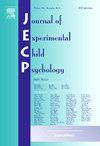Smiling, face covering, and rhythmic body rocking in children who cheat versus do not cheat
IF 1.8
2区 心理学
Q3 PSYCHOLOGY, DEVELOPMENTAL
引用次数: 0
Abstract
Cheating is the behavioral realization of immoral decisions. It is a dynamic process that does not begin or end on the enactment of cheating. However, little research has closely looked at the behavioral dynamics of the cheating process. The current study analyzed smiling, face covering, and rhythmic body rocking among 4- to 7-year-old children (N = 120) who participated in a challenging math test. We compared these target expressive behaviors from baseline practice trials to the critical test trial. Compared with children who did not cheat, we found that those who cheated were more likely to display smiling during the critical test trial, and those who cheated were more likely to cover their faces throughout the experiment even before they had the opportunity to cheat. Rhythmic body rocking did not differ between cheating and non-cheating children. The study identified behavioral differences between children who cheated and those who did not cheat, laying the groundwork for understanding children’s cheating behaviors from the lens of behavioral dynamics. It also suggests that with further research there might be some potential for distinguishing between these groups based on behavioral cues.
作弊与不作弊儿童的微笑、捂脸和有节奏的身体摇摆。
作弊是不道德决定的行为实现。它是一个动态的过程,并不因作弊行为的发生而开始或结束。然而,很少有研究仔细观察作弊过程的行为动态。本研究分析了参加高难度数学测试的 4 至 7 岁儿童(120 人)的微笑、捂脸和有节奏的身体摇摆等行为。我们将这些目标表达行为从基线练习试验到关键测试试验进行了比较。我们发现,与没有作弊的儿童相比,作弊的儿童更有可能在关键测试试验中表现出微笑,而作弊的儿童则更有可能在整个试验过程中,甚至在有机会作弊之前就遮住自己的脸。有节奏的身体摇摆在作弊儿童和非作弊儿童之间没有差异。这项研究发现了作弊和不作弊儿童之间的行为差异,为从行为动力学的角度理解儿童的作弊行为奠定了基础。研究还表明,通过进一步研究,有可能根据行为线索来区分这些群体。
本文章由计算机程序翻译,如有差异,请以英文原文为准。
求助全文
约1分钟内获得全文
求助全文
来源期刊

Journal of Experimental Child Psychology
Multiple-
CiteScore
4.50
自引率
7.70%
发文量
190
期刊介绍:
The Journal of Experimental Child Psychology is an excellent source of information concerning all aspects of the development of children. It includes empirical psychological research on cognitive, social/emotional, and physical development. In addition, the journal periodically publishes Special Topic issues.
 求助内容:
求助内容: 应助结果提醒方式:
应助结果提醒方式:


